The hidden costs of video streaming services in MATs and schools
Ask a school leader what keeps them up at night and it won’t take long for the word ‘budget’ to be mentioned. Nearly half of multi-academy trusts (MATs) in England were in deficit in 2023. The situation has led to a 42% increase in MATs with financial reserves below DfE thresholds.
Against this backdrop, school and MAT leaders are constantly looking for ways to cut costs or avoid new investments. But when it comes to the use of video in classrooms, it pays to dig a little deeper into the real cost of neglecting a proactive strategy.
The cost of contravening platforms’ terms of service
The DfE buys copyright licences for state-funded primary and secondary schools in England, covering a wide range of collateral and media, from newspapers to BBC broadcasts. (Sixth form colleges and independent schools are not covered by government-funded licences.) Similar provisions are in place across Scotland, Wales and Northern Ireland.
But there are two important nuances to be aware of.
Whose streaming service are your teachers using?
Your school may be covered to show BBC programmes, thanks to the funded licences. But what about other TV shows and films on platforms like Netflix and Amazon Prime? 60%* of teachers in England (rising to 75% among primary teachers) have used their personal streaming accounts to show video in class, which violates the terms of service of these platforms.
The YouTube exception
YouTube, despite being banned for use by pupils in some schools, is often used by teachers as a source of video clips for teaching. But the DfE expressly excludes content directly accessed from YouTube from its licencing agreements. What’s more, YouTube’s own terms of service specify that users may view content for personal use only.
Violating terms of service or infringing copyright law opens schools up to potential fines – not to mention staff time in dealing with cease and desist letters or other related communications.
The cost in teachers’ time
Another consideration is that while the DfE pays for licences, it – naturally – doesn’t curate and vet videos, ensure they’re aligned to the curriculum, or categorise them by year group, subject or topic.
Teachers must spend their own precious time researching and vetting videos to show in class – time which would be far better spent on other tasks.
In order to fully vet a video, teachers should watch it all the way through before playing it in class. If not, they risk exposing their students to inappropriate or offensive content: almost one-fifth (18%) have had unsafe content appear in a video which they thought would be suitable to show to their class.*
As well as pre-watching the chosen video, it takes time to trawl YouTube or other streaming services to find the clip in the first place. Given that 91% of teachers use video in class*, and the average YouTube video is around 11 minutes long, altogether that adds up to hours of wasted teaching resource every month.
The cost in terms of safeguarding issues
Sourcing video from non-education-focused sites to use in class is a minefield. YouTube (other than YouTube Kids) can’t be used for children under thirteen years of age without violating its terms of service. If teachers use their own YouTube accounts, they risk being embarrassed by personalised content suggestions – we’ve heard many instances of female teachers targeted by pregnancy test adverts, for instance. Worse, over half (53%) of teachers experience inappropriate, embarrassing or unsafe content in YouTube adverts when showing videos in the classroom*.
The risk in terms of children’s wellbeing is a major consideration when counting the potential costs of video streaming. Not to mention the impact on teachers’ mental health due to the stress of inadvertently exposing their class to disturbing content – and the school’s administrative time and reputational impact when dealing with the fallout.

The cost of ‘free’ streaming
There is a misconception that using YouTube is a ‘free’ option. As with many online services, you can assume that if you’re not paying a fee, then you (and your data) are the product. Brands and content producers pay YouTube to advertise to you: YouTube’s global advertising revenues hit $31.5 billion in 2023. Even if teachers are avoiding adverts in class by using premium accounts or filtering services, they may be encouraging students to carry out self-directed research at home. Children are then at risk of being exposed to adverts while browsing YouTube alone.

The cost to educational outcomes
Video is a fantastic resource to help teachers bring a topic to life. But a clip that doesn’t align with the curriculum, is inaccurate or outdated, or has unexpected content that distracts the class, can do more harm than good.

Taking a proactive approach to cost-saving
Around the world, more than 6,000 schools have signed up to ClickView and stay with us, year after year. They tell us they find the investment in our platform is easily outweighed by the cost-savings we deliver in:
- Potential copyright and terms of service violations – ClickView is home to all the best on-demand, copyright cleared and ad-free, movies and TV programmes. What’s more, everything from CPD to curriculum materials can be stored within the platform, to avoid the data privacy and security risks that come from uploading and sharing via free video streaming services.
- Teachers’ time – We curate and categorise all videos on clickview.net to make it easy to find the right clip in under a minute. Videos are curriculum-aligned, age-appropriate, and cover every key stage and curriculum topic area. Teachers can save useful clips into a shared library for other staff to access, reducing time across the whole school.
- Safeguarding issues – Videos are fully vetted and ad-free. Teachers can share videos through the learning management system (LMS) so students can safely conduct their own video-based learning out of the classroom.
- Educational outcomes – ClickView is constantly updated and comes with classroom-ready resources. Teachers can add their own interactive video quizzes, and use the analytics to see who’s watched what outside the classroom, and how well they understood the subject.

MAT and school leaders already have plenty to worry about, without video streaming adding to their anxieties. This is how Christalla Jamil, FCCT, CEO, LDBS Academies Trust puts it:
ClickView adds a layer of security to our teaching and learning materials through their safe selection of resource. As a CEO of twelve schools this gives me peace of mind.
Trialling ClickView is completely free – and might save you a huge amount in the long run.
Get in touch to organise a demo for your school.
*Teacher Tapp Survey of 7,000 UK teachers carried out in June 2023

Michael Wilkinson
briefcase iconManaging Director
Michael Wilkinson is the UK Managing Director of ClickView, an award-winning curriculum resource, trusted by over 7,000 schools and colleges. ClickView is home to a wide range of curriculum-aligned video content, plus the best educational documentaries, TV series and feature films, improving student engagement, reducing teacher workload and enhancing learning.
Other posts
Want more content like this?
Subscribe for blog updates, monthly video releases, trending topics, and exclusive content delivered straight to your inbox.






